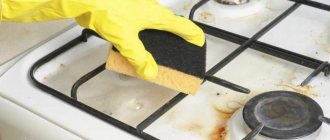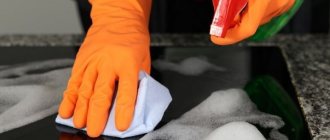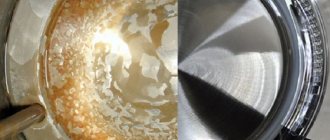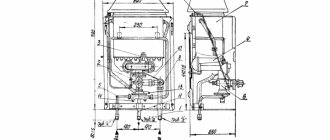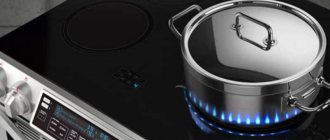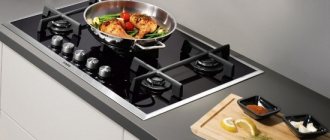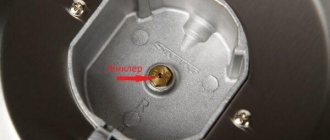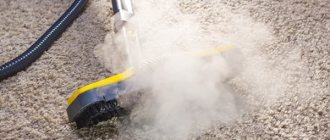Drops of fat, soot, food particles that settle on the grate bars during the cooking process - all this over time turns into a dense layer of soot, which is very difficult to get rid of.
It is possible to simplify the cleaning process as much as possible and achieve the desired result of shining gas stove grates only if the method and cleaning composition are correctly selected.
We will tell you in this article how to clean the grate of a gas stove from carbon deposits at home.
How to remove using folk remedies?
When cleaning gas stove grates, you should start with available means at hand (we save money and time spent on buying household chemicals).
Soda
Dry baking soda powder is a natural abrasive that perfectly cleans steel and cast iron rods.
Algorithm of actions:
- baking soda is diluted to a thick paste;
- the finished product is applied to the grill and left for thirty minutes;
- The treated surfaces are thoroughly rubbed with a brush or a hard sponge, and then washed off with warm water.
It is better to apply the baking soda paste to the slightly moistened surface of the rods.
Mustard
Fresh mustard or dry mustard powder is a gentle means for cleaning grates from carbon deposits (does not leave scratches or abrasions).
Algorithm of actions:
- Wipe the grill thoroughly with a damp cloth.
- Dry mustard is diluted with water to form a thick paste.
- The prepared mixture is applied to each rod and left for at least three hours.
- Treated surfaces are thoroughly wiped with a rag, hard sponge or brush.
There is no need to dilute fresh mustard with water before applying it to the grill.
Laundry soap and office glue
A product whose effectiveness has been tested by time is a mixture of soap and office glue.
The alkalis contained in the glue enhance the cleaning properties of soap, helping to dissolve hardened layers of fat and soot.
Algorithm of actions:
ten liters of water are poured into a bowl or large saucepan, in which 150 ml of office glue and a bar of laundry soap grated on a coarse grater are stirred;- place the prepared pan on the fire and bring its contents to a boil;
- I lower the dirty grates into boiling water and continue the boiling process for another hour;
- after sixty minutes, remove the pan from the heat, remove the grates, clean each rod with a stiff sponge or brush;
- the already cleaned surface is washed again under warm running water.
During the boiling process, make sure that the grate is completely immersed in water. The boiled liquid is added as needed.
Dry mustard
Another technique for those who cannot or do not want to use chemicals to clean a gas stove. With the help of dry mustard you can get rid of fat deposits, but not soot.
- Remove as much grease as possible with steel wool
- Wet the entire surface.
- Sprinkle everything evenly with mustard powder.
- Wait 2 hours.
- Use a medium-hard brush to remove softened fat.
If necessary, the procedure can be repeated an unlimited number of times.
Using household chemicals
Special chemical compounds designed to remove stubborn fat deposits, soot and soot will quickly return the gas stove grate to its original appearance. There is a wide range of household chemicals on the shelves of hardware stores.
Gels carefully remove grease, do not leave scratches , and are ideal for any materials. When choosing a cleaning spray, you must carefully study the composition (high concentrations of acids and alkalis are dangerous for cast iron and enameled surfaces). Otherwise, the spray is very convenient to use; it helps to save product consumption by spraying it onto the surface through a special spray bottle.
Abrasive powders are attractive at a fairly low cost (an order of magnitude lower than the price of a gel or spray). But abrasive is not suitable for glossy surfaces. In other cases, before application, it is recommended to dilute the powder with water to form a thick paste.
TOP - the most effective means of removing carbon deposits from a gas stove grate:
Top House Grease Cleaner
Will dissolve without residue:
- congealed fat,
- soot,
- burnt food.
Polishing microgranules in the spray will return the original gloss to the gas stove grate. After using the spray, a protective film is formed on the surface, making subsequent cleaning easier.
A convenient spray bottle helps to save cleaning product consumption. The average cost is 400 rubles. (500 ml bottle). Read reviews here.
Mr. Chister
In just three minutes it will remove stubborn grease, soot and carbon deposits from the grate of a gas stove . It is enough to spray the composition onto the contaminated surface, wait a little and rinse with warm water. The average cost is 220 rubles. (500 ml bottle). Read reviews here, on this and this review site.
Grease remover spray Sanita
The product from a Russian manufacturer is suitable for removing particularly difficult contaminants (grease, soot, burnt food). Recommended for treating gas stove grates and other kitchen surfaces made of:
- become,
- cast iron,
- enamel,
- stainless steel
Simply spray the product onto the stain, wait one minute, and rinse with warm water. The average cost is 170 rubles. (500 ml bottle). Read reviews here, here and here.
You can work with household chemicals only after thoroughly studying the manufacturer’s instructions, in a well-ventilated area, using protective rubber gloves.
Heat treatment
Roasting metal with an open fire (calcination or heat treatment) is an excellent way to quickly clean the steel grates of a gas stove from dense layers of carbon deposits. This type of cleaning cannot be used for cast iron or enamel rods.
The steps are simple: using the open flame of a blowtorch, the burners of the gas stove burn the rods of the gas grate. Under the influence of high temperatures, the fat breaks down into tiny particles and all that remains is to wipe the surface with a clean damp cloth.
Ready-made degreasing products
Buy household chemicals designed specifically for cleaning ovens and stoves. Read the label carefully to determine which material the product is suitable for. The table shows sprays for cleaning gas stoves from grease.
Table 1. Ready-made grill cleaning products
| Name | Manufacturer | Volume, ml | price, rub. |
| Selena | Russia | 500 | 110 |
| Sanitol | Russia | 250 | 60 |
| "Lyme Anti-Fat" | Russia | 500 | 120 |
| Gold Unicum | Russia | 500 | 165 |
| Sanita gel Anti-grease | Russia | 500 | 75 |
| Reinex | Germany | 750 | 270 |
| Cif | Hungary | 750 | 150 |
| Super Sanitar | Russia | 500 | 65 |
| Synergetic | Russia | 500 | 250 |
| "Shumanit" | Israel | 500 | 450 |
Important. Chemicals should only be used for their intended purpose. Wear gloves and ventilate the area while working.
Wire brush
Hard cleaning with metal brushes is suitable when the grate on the gas stove is not removable.
Algorithm of actions:
- the rods are moistened with water;
- using a stiff metal brush, scrape off dirt with active circular movements;
- The cleaned surface is wiped with a clean damp cloth.
You can simplify the mechanical cleaning process if you use a drill with a special brush attachment.
Cleaning features depending on the material
The first thing you need to do when starting to clean the gas stove grate is to find out what material it is made of. This knowledge directly influences the choice of cleaning method and type of detergent.
Cast iron
Cast iron rods are very difficult to maintain . Cast iron scratches very easily. Therefore, such products cannot be scraped with a knife or other sharp objects, or be beaten off the surface with a hammer. Cast iron does not withstand the aggressive effects of acidic compounds.
The best option for cast iron grates is cleaning with a steam generator or heat treatment (cast iron tolerates heat very well).
Stainless steel
Stainless steel gratings are resistant to chemicals and abrasives. Stainless steel is easy to clean from carbon deposits using a wire brush, sand or soda. It is enough to slightly moisten the metal with water, and then thoroughly rub the stains.
Enamel
Lightweight enamel-coated gratings are sensitive to rough mechanical and aggressive chemical influences.
The method of soaking in a soap solution will help remove carbon deposits from such surfaces . Dissolve 100 ml of liquid dishwashing detergent in 10 liters of water.
The frying pan is soaked in the resulting mixture for at least six hours, after which the dirt can be easily removed with a soft brush or sponge.
Cleaning details depending on the grate material
All methods are effective in the fight against stubborn grease and soot, but not all are universal for different surfaces.
Cast iron
It is not advisable to subject a cast iron product to rough processing and cannot be washed in the dishwasher. Harsh mechanical impact will damage the coating, and when washed in PMM, under the influence of hot steam, the top layer of metal is destroyed, which will soon lead to corrosion.
The soaking method is also not suitable for cast iron. The optimal method of cleansing is calcination.
Enameled steel
Enamel does not tolerate rough scraping with metal brushes, a knife or other hard objects. Such methods damage the surface, causing chips and scratches. All other methods can be used safely, but the most suitable is washing in the dishwasher.
Stainless steel
Stainless steel products are the most unpretentious; they can be safely cleaned with caustic detergents, scrubbed with a wire brush, and soaked. Even if scratches remain after cleaning, they will not affect the further operation and service life of the product.
How to prevent plaque from appearing?
To ensure that your gas stove grate always shines clean, you must follow these rules:
- Cleaning - after each cooking . There's nothing easier than wiping down the grill with a damp cloth at the end of the day. Spending two minutes on regular cleaning will save two hours on removing stubborn grease and grime.
- A chip-free surface means less dirt . The fewer scratches, abrasions and chips there are on the gas grill, the easier it is to keep it clean.
A life hack from experienced housewives: coarse salt, sprinkled on greasy stains immediately after they appear, prevents grease particles from attaching to the grate of the gas stove.
Adviсe
A few tips from experienced housewives will make the difficult process of cleaning carbon deposits from gas grills easier:
- Fresh traces of soot can be easily removed with lemon juice. It is enough to wipe the rods with a slice of fresh citrus and there will be no trace of greasy stains left.
- The soaking time in the soap solution should not exceed six hours. Prolonged contact with water destroys the protective layer of metal rods.
- Liquid for washing car engines is an effective tool in the fight against carbon deposits on cast iron grates.
Life hack: using cookware with high sides helps keep the grates and work surface of the gas stove clean.
Methods and means for cleaning various surfaces from carbon deposits are presented in this section.
Preparing for cleaning
First, find out what the bars are made of. Then select a suitable substance and prepare rubber gloves, sponges, rags, and brushes.
The choice of cleaning method depends on the design. If the bars are removable, it will be easier and faster. Check the grille and remove rubber and plastic parts to avoid damaging them during cleaning. Wet the structure with cleaning agent in a suitable container.
It is more difficult to clean the structure attached to the hob. Soaking is not possible. You will need to clean the mesh directly on the hob. For convenience, use different brushes to reach all corners. Foil or oilcloth should be placed under the structure so as not to contaminate the surface of the oven during cleaning. Before cleaning, turn off the gas.
